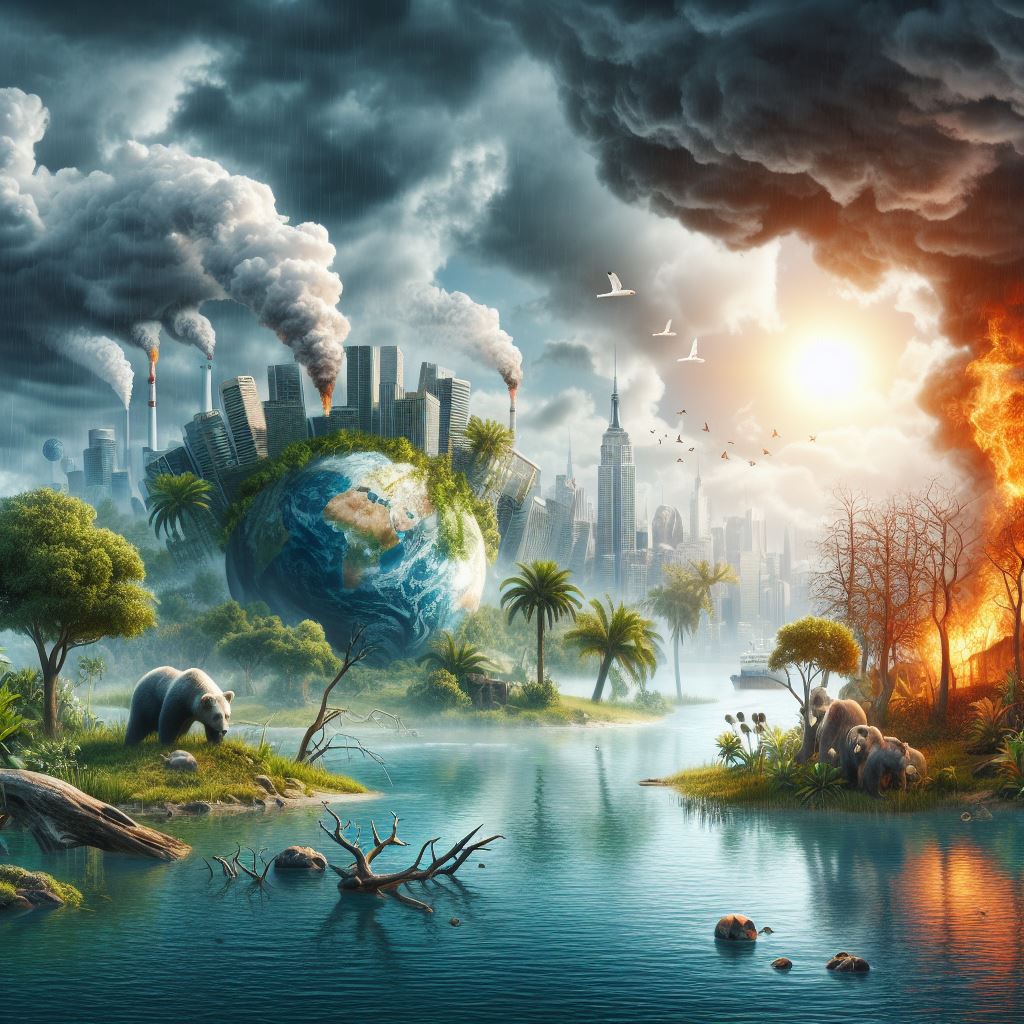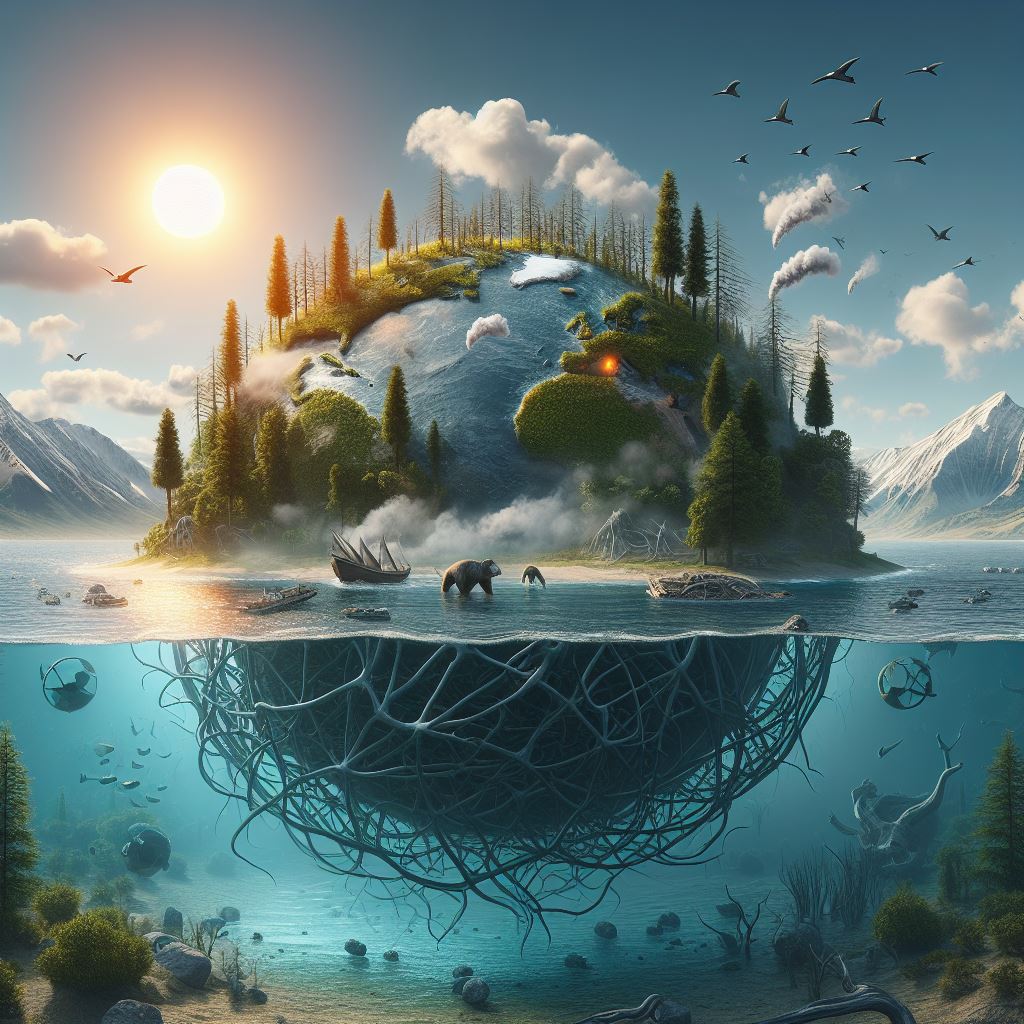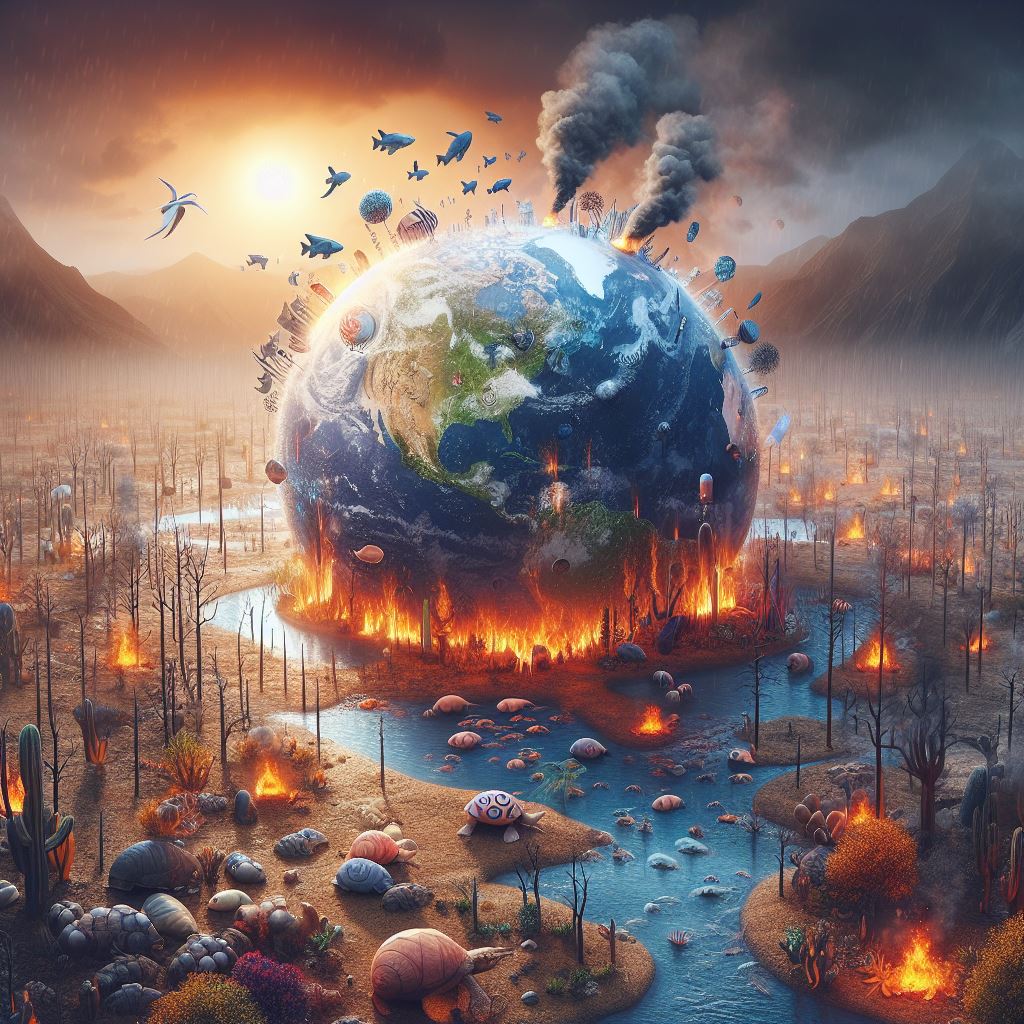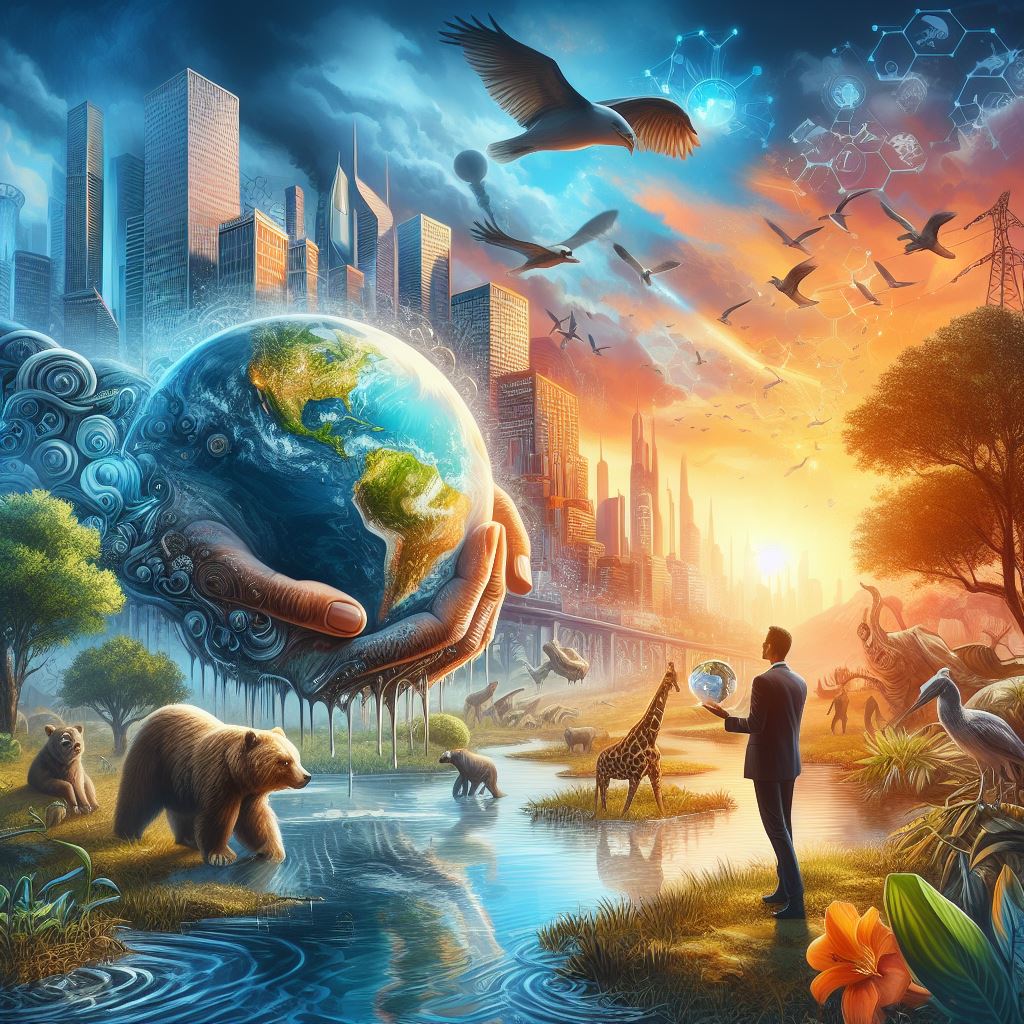Introduction:
In the symphony of Earth’s changes, the notes of climate change resonate with increasing urgency. Over the last century, our planet has warmed by a staggering 1.2 degrees Celsius, a shift that transcends mere statistics and enters the realm of tangible consequences. As we stand witness to a warming world, it is vital to recognize the interconnectedness of all life forms, particularly those inhabiting the diverse ecosystems that define our planet.
Climate Change:

Climate change is not an abstract concept relegated to scientific discussions but a tangible transformation reshaping our environment. It stems from the accumulation of greenhouse gases—carbon dioxide, methane, and others—in our atmosphere. These gases trap heat, elevating global temperatures and setting in motion a cascade of alterations in weather patterns, sea levels, and the delicate equilibrium of our ecosystems.
The Crucial Focus on Wildlife:
Amidst this global metamorphosis, wildlife emerges as both witness and victim. The consequences of climate change reverberate through the intricate tapestry of nature, affecting species in ways both subtle and profound. Understanding the nuanced impact on wildlife is not merely a scientific pursuit but a moral imperative. Wildlife is not merely an observer of environmental shifts; it is an integral participant, woven into the very fabric of our ecosystems. The health and vitality of our planet are inseparably linked to the well-being of its inhabitants, and as stewards of this fragile balance, we must delve into the heart of how climate change threatens the survival of countless species.
In the exploration that follows, we journey into the realms where climate change intersects with the intricate lives of wildlife. This is a narrative of adaptation and vulnerability, of ecosystems in flux, and the urgent need to chart a course towards a sustainable coexistence. The fate of wildlife is entwined with our own, and understanding the profound impact of climate change on these fellow inhabitants is an essential step toward collectively forging a resilient and harmonious future for all life on Earth.
Focus on Wildlife:

In the midst of the symphony of climate change, wildlife stands as a poignant and vulnerable soloist, facing the crescendo of environmental shifts. Our planet’s diverse ecosystems, once harmonious in their intricate balance, are now grappling with disruptions that echo across species and habitats. It is within this ecological intricacy that the true gravity of climate change becomes profoundly evident.
Wildlife, with its myriad forms and functions, serves as both the sentinel and barometer of environmental change. The consequences of a warming world extend far beyond rising temperatures and altered landscapes; they weave a narrative of survival, adaptation, and, unfortunately, loss. The survival of countless species hinges on their ability to navigate this changing reality, a reality shaped by human-induced climate change.
Understanding the intricate dance between climate change and wildlife is not merely an academic pursuit—it is a call to empathy, an acknowledgment of our shared responsibility as stewards of this planet. From the microscopic organisms that sustain ecosystems to the charismatic megafauna capturing our imaginations, each species plays a unique role in the grand tapestry of life. As we navigate the nuances of how climate change impacts wildlife, we embark on a journey into the heart of conservation, adaptation, and the delicate balance between human progress and ecological preservation.
In the following exploration, we delve into the stories of species facing unprecedented challenges, habitats undergoing transformative shifts, and the crucial interplay between human activities and the well-being of our fellow inhabitants. The focus on wildlife is not just a lens through which we examine the impacts of climate change; it is a prism refracting the urgency for collective action and a shared commitment to safeguarding the biodiversity that defines our planet.
Overview of Climate Change Effects on Ecosystems:
Science of Climate Change:
At the heart of the profound changes we observe in our environment lies the intricate science of climate change. The primary driver is the enhanced greenhouse effect, a natural phenomenon vital for maintaining Earth’s temperature. However, human activities, such as burning fossil fuels and deforestation, have significantly amplified this effect.
- Greenhouse Effect: The greenhouse effect is a natural process where certain gases in the Earth’s atmosphere, such as carbon dioxide and methane, trap heat from the sun, preventing it from escaping back into space. This process is crucial for maintaining a livable temperature on our planet.
- Enhanced Greenhouse Effect: Human activities have substantially increased the concentration of greenhouse gases, enhancing the natural greenhouse effect. This intensification results in the retention of more heat in the atmosphere, leading to a gradual warming of the Earth’s surface—a phenomenon commonly referred to as global warming.
Temperature Changes:
The consequences of climate change are palpable in the rising temperatures that sweep across the globe. These temperature shifts have far-reaching implications for ecosystems and the myriad species that inhabit them.
- Impact on Wildlife Habitats: As temperatures rise, wildlife habitats undergo transformative changes. Many species are adapted to specific temperature ranges, and even small deviations can disrupt their natural behaviors, migration patterns, and reproductive cycles. For instance, polar bears rely on the presence of sea ice for hunting and breeding; as this ice diminishes due to warming temperatures, their survival is imperiled.
- Altered Ecosystem Dynamics: Rising temperatures also affect the delicate balance within ecosystems. They can lead to shifts in the distribution of plant and animal species, influencing predator-prey relationships, competition for resources, and the overall structure of ecological communities. Some species may thrive in warmer conditions, while others face the challenge of adapting or migrating to more suitable environments.
- Extreme Weather Events: The warming climate contributes to the increased frequency and intensity of extreme weather events, such as heatwaves, droughts, and intense storms. These events further stress ecosystems, leading to disruptions in food chains, habitat destruction, and increased vulnerability for various species.
Understanding the impact of rising temperatures on ecosystems and wildlife is pivotal in formulating strategies for conservation and adaptation. In the subsequent sections, we will explore specific examples of species facing these challenges and delve into the broader strategies aimed at mitigating the effects of climate change on our planet’s biodiversity.
Address Changes in Precipitation Patterns:
Impact on Biodiversity: Changes in precipitation patterns, a hallmark of climate change, have profound implications for biodiversity. The availability and distribution of water play a fundamental role in shaping ecosystems. Altered rainfall patterns can lead to droughts or floods, creating challenges for the plants and animals adapted to specific moisture conditions.
- Drought Impact: Extended droughts can parch landscapes, diminishing water sources critical for various species. This puts stress on flora and fauna, affecting their ability to thrive, reproduce, and maintain ecological balance. Water-dependent species, such as amphibians and certain plant species, may face population declines or habitat loss.
- Flooding Consequences: Increased rainfall in some areas can lead to flooding, disrupting ecosystems adapted to drier conditions. Flooded habitats may displace species unaccustomed to such inundation, potentially causing shifts in community dynamics. This can result in the displacement or decline of species not adapted to the changing water levels.
Understanding the intricate relationship between precipitation patterns and biodiversity is essential for predicting and addressing the consequences of climate change on ecosystems.
Highlight Extreme Weather Events:
Impact on Wildlife: Extreme weather events are becoming more frequent and severe in the era of climate change, posing immediate threats to wildlife and their habitats.
- Hurricanes and Coastal Ecosystems: Hurricanes and tropical storms can wreak havoc on coastal ecosystems. Rising sea levels and storm surges can inundate habitats, affecting marine life, nesting sites for birds, and the delicate balance of coastal ecosystems. Species like sea turtles, shorebirds, and marine fauna face increased vulnerability.
- Wildfires and Habitat Destruction: More frequent and intense wildfires, fueled by higher temperatures and prolonged droughts, can lead to widespread habitat destruction. Wildlife adapted to specific vegetation and ecosystems may struggle to survive in the aftermath of fires. Ground-dwelling species, in particular, may lose crucial cover and face increased predation risks.
- Heatwaves and Stress: Prolonged periods of extreme heat can stress ecosystems by altering food availability and water sources. Heatwaves can lead to heat stress and mortality in species not adapted to such elevated temperatures. This is particularly concerning for species in regions unaccustomed to extreme heat events.
Understanding how extreme weather events impact wildlife is essential for crafting effective conservation strategies. By addressing these challenges head-on, we can work towards preserving the resilience and diversity of our planet’s ecosystems in the face of a changing climate.
Ocean Acidification:
Impact on Marine Ecosystems: Ocean acidification, a consequence of climate change, is a phenomenon with profound implications for marine ecosystems. As carbon dioxide (CO2) emissions rise, a significant portion is absorbed by the world’s oceans, leading to chemical changes in seawater. This process results in the water becoming more acidic, primarily due to the formation of carbonic acid.
- Coral Reefs and Shellfish: Ocean acidification poses a direct threat to marine organisms that build skeletons or shells from calcium carbonate, such as corals and shellfish. As the acidity of seawater increases, the availability of carbonate ions crucial for these organisms to form their protective structures diminishes. This can lead to the weakening and dissolution of coral reefs, impacting the entire ecosystems that depend on them. Shell-forming organisms, including mollusks and certain plankton, may struggle to maintain their structures, affecting their survival and disrupting food webs.
- Fish and Marine Life: Beyond impacting calcifying organisms, ocean acidification also affects fish and other marine life. Changes in acidity can interfere with the sensory abilities of some fish species, affecting their ability to navigate, find prey, or avoid predators. Additionally, alterations in the distribution and abundance of plankton—the foundation of marine food webs—can have cascading effects throughout the entire ecosystem, impacting fish populations and, consequently, human fisheries.
- Ecosystem Resilience: The overall resilience of marine ecosystems is challenged by ocean acidification. As the chemistry of seawater changes, the delicate balance of relationships between different species may shift. This can result in increased competition for resources, changes in predator-prey dynamics, and potential declines in biodiversity.
Understanding the intricacies of ocean acidification is crucial for developing strategies to mitigate its impact. As we explore the effects of climate change on marine ecosystems, addressing this specific challenge becomes imperative to safeguard the health and sustainability of our oceans.
Species at Risk Due to Climate Change:
Vulnerable Species: Climate change poses a significant threat to various species, pushing many to the brink of extinction. Specific examples highlight the vulnerability of wildlife to changing environmental conditions.
- Polar Bears (Ursus maritimus): Polar bears, iconic inhabitants of the Arctic, face considerable challenges due to the loss of sea ice—a consequence of global warming. The bears rely on sea ice as a platform for hunting seals, a crucial food source. With the diminishing ice, polar bears are forced to travel longer distances, expending more energy and facing increased difficulty in securing sustenance.
- Adélie Penguins (Pygoscelis adeliae): Adélie penguins, native to Antarctica, are experiencing habitat changes due to warming temperatures. As ice shelves break apart, the penguins lose crucial nesting sites. Changes in the distribution and abundance of their prey, such as krill, further threaten their survival.
- Koalas (Phascolarctos cinereus): Koalas in Australia are grappling with the increasing frequency and intensity of heatwaves, a result of climate change. These heatwaves exacerbate dehydration and heat stress in koalas, leading to declines in their populations. Additionally, changes in eucalyptus tree distribution, their primary food source, further challenge their survival.
Migration Challenges:
Climate change disrupts the delicate balance of ecosystems, impacting the natural cues and conditions that guide the migratory patterns of various species.
- Bird Migration: Many bird species, such as the Arctic tern and Swainson’s hawk, rely on precise seasonal changes to trigger their migrations. Shifts in temperature, altered wind patterns, and changes in the availability of food sources disrupt these cues. Birds may find themselves out of sync with the timing of their migration, leading to challenges in finding suitable breeding and feeding grounds.
- Marine Species: Ocean currents, influenced by temperature and salinity, guide the migratory routes of marine species like sea turtles and whales. Climate-induced changes in ocean circulation can alter these currents, affecting the timing and pathways of migration. For example, loggerhead turtles may face challenges navigating altered sea currents during their long-distance journeys.
- Terrestrial Mammals: Land-based mammals, including caribou and wildebeest, depend on specific vegetation and weather patterns during their migrations. Altered climate conditions can affect the availability of food along their routes, leading to longer and riskier journeys. This can result in increased mortality rates, especially among young or vulnerable individuals.
Examine Habitat Loss:
Habitat loss, driven by alterations in temperature, precipitation patterns, and other climate-related factors, has severe consequences for diverse ecosystems and the species that inhabit them.
- Amazon Rainforest: The Amazon rainforest, home to an astonishing array of biodiversity, is under threat due to changing climate conditions. Increased temperatures and alterations in rainfall patterns contribute to prolonged droughts and more frequent wildfires. This, coupled with deforestation, leads to habitat loss for countless species, including jaguars, tree frogs, and a myriad of plant species.
- Coral Reefs: Rising sea temperatures and ocean acidification contribute to the bleaching and degradation of coral reefs. These vibrant ecosystems provide critical habitats for a vast number of marine species. As coral reefs decline, species such as various fish, sea turtles, and invertebrates lose their shelter and breeding grounds.
- Arctic Tundra: The Arctic tundra is experiencing rapid warming, causing permafrost thaw and altering vegetation patterns. This impacts species like the Arctic fox, caribou, and migratory birds that rely on the unique tundra ecosystem. Changes in vegetation affect the availability of food and nesting sites, leading to disruptions in their life cycles.
Understanding the specific species and ecosystems at risk due to climate change is pivotal for developing targeted conservation efforts. Mitigating habitat loss and protecting vulnerable species are crucial steps in ensuring the resilience and sustainability of our planet’s biodiversity.
Threat of Invasive Species:
Climate change creates conditions conducive to the expansion of invasive species, disrupting ecosystems and threatening native flora and fauna.
- Altered Temperature Ranges: Warmer temperatures can extend the suitable habitats for invasive species, allowing them to thrive in regions where they were previously restricted. This can lead to competition for resources with native species and, in some cases, the displacement of native flora and fauna.
- Changing Water Temperatures: In aquatic ecosystems, rising temperatures can impact the distribution of invasive aquatic species. Warmer water conditions may provide a more favorable environment for invasive fish, plants, or mollusks, allowing them to outcompete native species and alter the balance of aquatic ecosystems.
- Increased Frequency of Extreme Events: Climate change contributes to the occurrence of extreme weather events such as storms, floods, and wildfires. These events can inadvertently aid the spread of invasive species by transporting seeds, spores, or organisms to new areas. Invasive species that are more resilient to such disturbances may gain a competitive advantage over native species.
Understanding and addressing migration challenges and the threat of invasive species are critical components of effective conservation strategies. By comprehending the complex interactions between climate change and wildlife, we can work towards preserving the integrity and biodiversity of ecosystems worldwide.
Explore Natural Adaptation Mechanisms:
Discuss How Some Species Have Evolved Natural Adaptations to Cope with Changing Conditions: Evolutionary processes have equipped certain species with the ability to adapt to changing environmental conditions over time.
- Camouflage and Coloration: Many species have evolved adaptive coloration or camouflage patterns that help them blend into their changing surroundings. This allows them to avoid predators or increase their chances of successful hunting.
- Changes in Behavior: Some animals adjust their behaviors to cope with shifts in climate or habitat conditions. For instance, altered migration patterns, changes in breeding times, or adjustments in foraging strategies can be natural responses to environmental variations.
- Physiological Adaptations: Certain species undergo physiological adaptations, such as changes in metabolic rates or the development of specific traits that enhance their resilience to new environmental challenges. For example, some amphibians exhibit adaptive responses to changes in temperature or moisture levels.
- Shifting Ranges: Some species respond to changing conditions by altering their geographic ranges. As temperatures change, certain plants and animals may migrate to higher altitudes or latitudes to find suitable habitats.
Human Intervention:
Conservation Efforts, Habitat Restoration, and Captive Breeding Programs: Human intervention is crucial for mitigating the impact of climate change on wildlife and fostering resilience in vulnerable species.
- Conservation Efforts: Conservation initiatives involve the protection and management of natural habitats, the establishment of protected areas, and the enforcement of regulations to prevent illegal activities such as poaching. These efforts contribute to maintaining biodiversity and ensuring the survival of endangered species.
- Habitat Restoration: Restoring degraded habitats is essential for providing suitable environments for wildlife. This may involve reforestation, wetland restoration, or efforts to rehabilitate ecosystems affected by human activities or climate change.
- Captive Breeding Programs: In cases where species face imminent threats or population declines, captive breeding programs play a vital role. These programs involve breeding and raising endangered species in controlled environments with the goal of reintroducing them into their natural habitats once conditions improve.
- Corridor Creation: Establishing wildlife corridors connecting fragmented habitats allows for the movement of species between different areas. This promotes genetic diversity, reduces the risk of inbreeding, and helps species adapt to changing conditions by facilitating migration.
- Climate-Resilient Planning: Human activities that contribute to climate change need to be mitigated. This includes reducing carbon emissions, transitioning to sustainable practices, and implementing climate-resilient land-use planning to minimize the impact on wildlife habitats.
By combining natural adaptation mechanisms with strategic human intervention, we can enhance the ability of wildlife to thrive in the face of climate change and promote the long-term health of ecosystems.
Importance of Corridors:
Significance of Wildlife Corridors in Facilitating Species Movement and Adaptation: Wildlife corridors are essential components of conservation strategies, providing interconnected pathways that enable species to move between fragmented habitats. The significance of these corridors lies in their ability to support biodiversity and foster adaptation in the face of changing environmental conditions.
- Genetic Diversity: Wildlife corridors facilitate the movement of individuals between populations, preventing genetic isolation. This promotes genetic diversity within species, which is crucial for their adaptability to changing environmental conditions. Increased genetic diversity enhances a population’s resilience to diseases, environmental stressors, and other challenges.
- Migration and Seasonal Movements: Many species, particularly large mammals and birds, undertake seasonal migrations or movements in search of food, water, or breeding sites. Wildlife corridors provide safe passages for these movements, allowing species to access critical resources without encountering insurmountable barriers such as roads or urban developments.
- Adaptation to Climate Change: Climate change necessitates the ability of species to shift their ranges in response to changing temperature and habitat conditions. Wildlife corridors act as conduits for species to migrate to more suitable environments, supporting their adaptation to a rapidly changing climate.
- Reducing Human-Wildlife Conflict: Corridors can mitigate conflicts between wildlife and human activities. By providing designated routes for animal movement, corridors help prevent situations where animals venture into populated areas in search of resources, reducing the likelihood of negative interactions.
- Ecosystem Connectivity: Corridors contribute to the overall connectivity of ecosystems. This connectivity allows for the movement of energy, nutrients, and species across landscapes, maintaining ecological processes and supporting the health of diverse ecosystems.
Examine Global Cooperation:
Need for International Collaboration in Addressing Climate Change and Protecting Wildlife: Climate change and its impact on wildlife transcend national borders, emphasizing the critical need for global cooperation in addressing these challenges.
- Shared Responsibility: Climate change is a global phenomenon driven by cumulative human activities. As such, addressing its impacts requires collective responsibility. Nations must work together to reduce greenhouse gas emissions, implement sustainable practices, and protect shared ecosystems.
- Transboundary Conservation: Many species have ranges that span multiple countries. International collaboration is essential for the development and implementation of transboundary conservation strategies, ensuring the protection of migratory routes, habitats, and shared biodiversity.
- Research and Data Sharing: Collaborative efforts in scientific research and data sharing are crucial for understanding the dynamics of climate change and its impact on wildlife. This shared knowledge enhances the effectiveness of conservation strategies and informs adaptive management approaches.
- Conservation Funding and Support: International collaboration allows for the pooling of resources, funding, and expertise to support conservation initiatives. Financial and technical assistance from developed nations can aid developing countries in implementing sustainable practices and protecting their biodiversity.
- Policy Harmonization: Harmonizing policies and agreements on climate change and wildlife conservation at the international level ensures that efforts are aligned and complementary. Treaties and agreements, such as the Paris Agreement, provide frameworks for nations to collectively address climate change and protect ecosystems.
In a world interconnected by ecosystems and climate systems, global cooperation is not just an option but a necessity. Collaborative efforts are fundamental to securing a sustainable future for both human societies and the diverse array of species that inhabit our planet.
Conclusion:

Summarize Key Points:
In summary, this article has explored the intricate relationship between climate change and wildlife, emphasizing three critical aspects:
- Climate Change Effects on Ecosystems: Rising temperatures, altered precipitation patterns, extreme weather events, and ocean acidification are reshaping ecosystems, threatening biodiversity across the globe.
- Species at Risk: Iconic species such as polar bears, Adélie penguins, and koalas face heightened vulnerability. Changing climate conditions disrupt migration patterns, while habitat loss threatens their very survival.
- Strategies for Adaptation and Mitigation: Natural adaptation mechanisms, human interventions like conservation efforts and habitat restoration, and the establishment of wildlife corridors are vital strategies for enhancing wildlife resilience.
Reiterate the Urgency:
The urgency to act cannot be overstated. Climate change poses an existential threat to the delicate balance of our planet’s ecosystems. The ripple effects on wildlife jeopardize biodiversity, disrupt ecosystems, and compromise the very foundation of life as we know it. The time to address this crisis is now.
Call to Action:
As stewards of this planet, we must take collective action to mitigate climate change and protect wildlife:
- Engage in Sustainable Practices: Reduce carbon footprints, adopt sustainable lifestyles, and support businesses committed to environmentally friendly practices.
- Support Conservation Initiatives: Contribute to and participate in conservation organizations working to protect habitats, species, and ecosystems.
- Stay Informed: Stay abreast of climate change developments, wildlife conservation efforts, and sustainable practices. Knowledge is a powerful tool for advocating change.
In the spirit of global cooperation, each individual’s actions contribute to a collective effort that transcends borders. By acting today, we pave the way for a future where wildlife thrives, ecosystems flourish, and our planet remains a vibrant and resilient home for generations to come.




